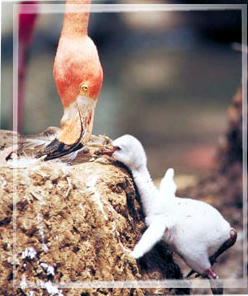Parents are able to recognize their own chick by sight and vocalizations. They will feed no other chick.
A flamingo chick will leave the nest after four to seven days, when it is strong enough to stand and walk. Parents keep a close, protective watch on their chick as it explores its habitat.
 Flamingo parents remain close-by as their chicks begin to explore their environment.
Flamingo parents remain close-by as their chicks begin to explore their environment.
Chicks gather in large groups called creches (French for “crib”). Parents are able to locate their own chicks in the creche at feeding time.
Adults feed their chicks a secretion of the upper digestive tract referred to as “milk”. “Milk” secretion is caused by the hormone prolactin, which both the male and female flamingo produce.
- ”Milk” is 8% to 9% protein and 15% fat, similar to mammal milk.
- ”Milk” is red in color due to the pigment canthaxanthin. Chicks store this pigment in the liver, to be deposited in their adult feathers when they grow.
CHICK DEVELOPMENT
Flamingo chicks are able to swim before they are typically old enough to leave the nest for good.
Young chicks have been seen imitating feeding methods while standing in shallow water.
Chicks begin to grow their flight feathers after 11 weeks. At the same time, the bill begins to hook, allowing the chick to feed itself.
Chicks lose their juvenile gray or white color gradually over a two or three year period, at which time their pink feathers begin to show.
HUMAN INTERACTION
Habitat destruction by humans has had a negative effect on the breeding and feeding grounds of flamingos.
- Construction of roads and highways make the flamingo’s environment more accessible to people and land predators.
- Coastal desert irrigation has altered water levels in many flamingo habitats.
- Mining of boron, lithium, nitrates, potassium, and molybdenum has caused habitat disturbances for the flamingos.
- Low-flying aircraft bringing tourists, bird enthusiasts, and photographers into flamingo nesting and feeding grounds cause disturbances and affect the birds’ lifestyle.
People have used flamingos and their eggs as food.
- Historically, people have used flamingo eggs as a primary food source and delicacy. Today, in some places, flamingo eggs are removed from nests and sold at markets.
- In early Roman times, flamingo tongues were carefully prepared, pickled, and served as a delicacy.
- Andean miners have killed flamingos for their fat, believed to be a cure for tuberculosis.
Greater and lesser flamingo chicks in the Magadi colony in Africa were banded in the 1960′s with the hope of finding out more about these birds’ lifestyles and migration patterns. Unfortunately, only a few of the banded birds have been recovered. It is believed that the bands may have dissolved because of the high alkaline content in the water where these birds live.
Human activity on Great Inagua Island in the Bahamas has helped flamingo populations. Salt production has added many acres of suitable habitat, stabilized water levels, and provided additional food sources.


